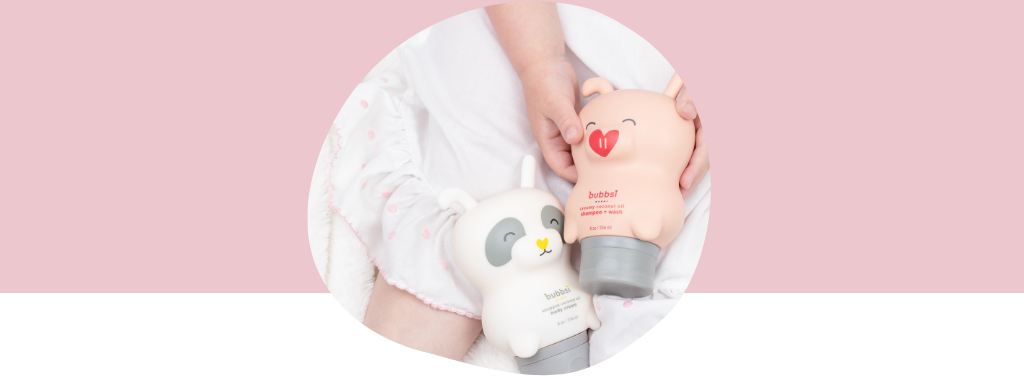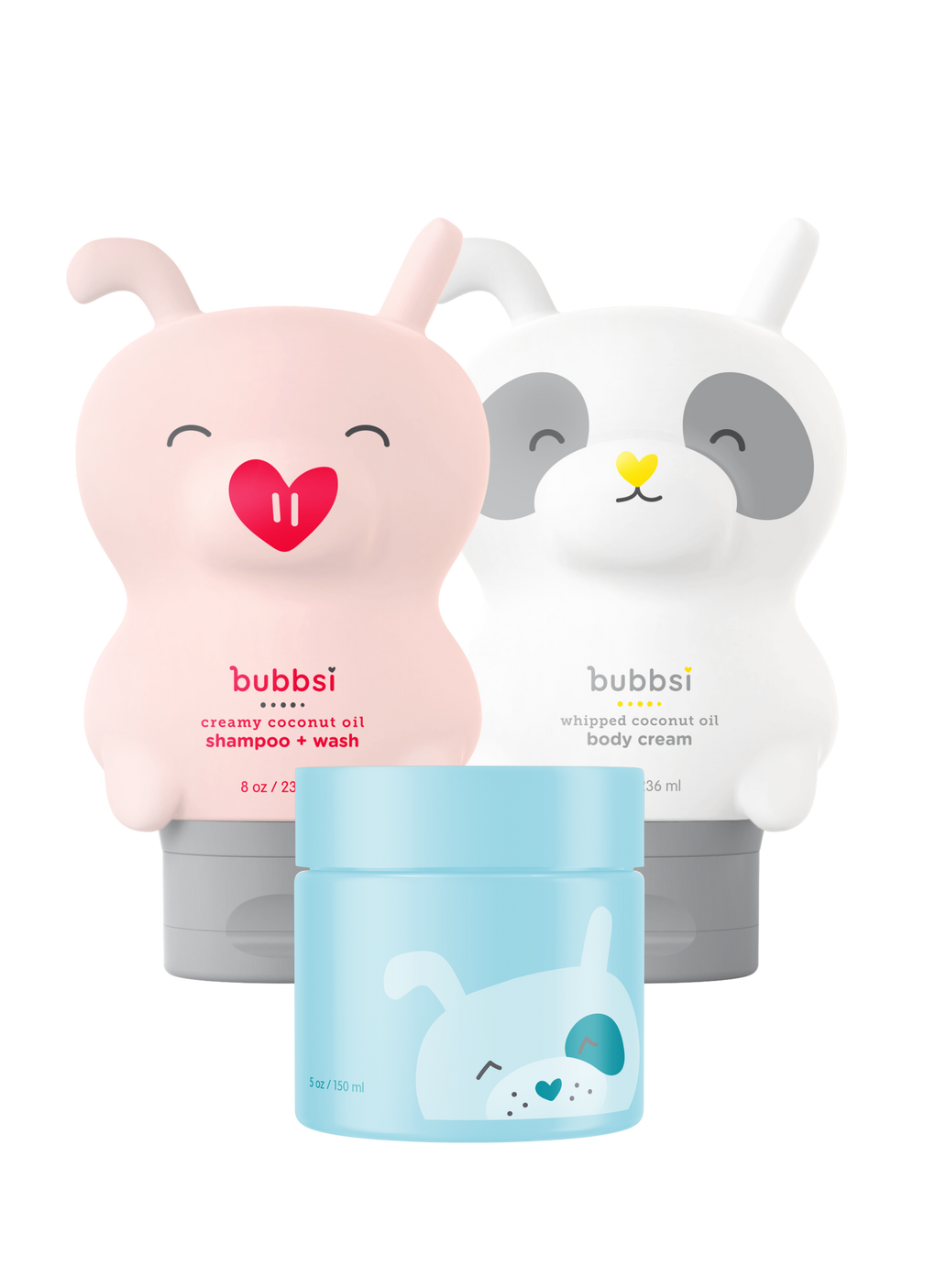So many sweet words come to mind when we think of the soft, snuggly skin of babies and toddlers. Two words that rarely do? Keratosis Pilaris. But as unwieldly, unwelcome and diagnostic as the name sounds, Keratosis Pilaris in babies and toddlers is actually a common skin condition. What’s more, it’s harmless, if sometimes itchy. Here, we discuss KP 101 and how Bubbsi’s moisturizing, all-natural coconut oil skincare products can treat Keratosis Pilaris in toddlers and babies without causing further irritation.
What is Keratosis Pilaris, What Does It Look Like, and How Will It Affect My Child?
Keratosis Pilaris, or what our grandparents might have referred to as “strawberry skin” or “chicken skin,” is a common, chronic skin condition that usually presents as small, hard, red or white bumps on the thighs, bum, cheeks or upper arms. According to the Cleveland Clinic, the most common age groups affected by Keratosis Pilaris are babies, toddlers and children going through puberty. About 50 to 80 percent of kids will have experienced KP by the time they’re teenagers, but the condition usually disappears completely by age 30.
The good news for parents of babies and toddlers is that Keratosis Pilaris is generally harmless and doesn’t hurt, but it can occasionally itch—causing the skin around the affected area to become irritated by excessive rubbing or scratching.

What Causes Keratosis Pilaris in Babies and Toddlers?
Simply put, KP is the result of excess keratin being produced, causing the skin around hair follicles to harden and scale over. While the appearance of KP and where it crops up on the body varies from person to person, the causes and contributors to this overabundance of keratin include all the usual suspects:
- Genetic: KP is considered an autosomal dominant-inherited disease, meaning that the child of a parent who has the mutated gene that causes it has a 50 percent chance of also inheriting that gene. Even if neither parent has ever shown signs of Keratosis Pilaris, babies and toddlers can inherit the gene.
- Environmental: While KP is not considered a seasonal condition, colder temperatures and dry air do tend to exacerbate it. As Dr. Blair Murphy-Rose, a dermatologist and clinical assistant professor at New York Presbyterian Hospital-Weill Cornell Medical Center told Vogue magazine: “Arid climates and dry skin worsens KP as skin cells are more adherent and shed less frequently when they are dry. Higher humidity levels and sunlight are believed to help with controlling KP."
- Related conditions: The American Academy of Dermatology Association (AAD) says people are also more likely to develop KP if they have the following conditions: Asthma, Dry skin, Eczema (atopic dermatitis), Hay fever, or Ichthyosis vulgaris (a skin condition that causes very dry skin).
While there doesn’t seem to be a link between diet and Keratosis Pilaris, toddlers and babies who are overweight may have a higher risk factor.
How is Keratosis Pilaris Different from Baby Eczema and Baby Acne?
Whenever our children show any signs of a skin condition, our first question is always going to be “What are those bumps on my baby’s skin?”
And while baby eczema and baby acne may look similar to Keratosis Pilaris in babies and toddlers, it’s important to know which condition you’re dealing with and how best to treat it. (For more information on treating baby eczema and baby acne, please click here.)
Baby eczema (atopic dermatitis) starts out with painfully itchy skin that develops scaly bumps that may crust over and/or weep after being scratched. It usually occurs between the ages of six months and five years, and can show up nearly anywhere on the body, but rarely occurs in the diaper area.
Baby acne often develops within the first two to four weeks after birth and is often the result of inflammation from yeast on the baby’s skin or overstimulated oil glands brought on by contact with hormones in the placenta. It shows up as small, hard, red or white bumps on the face, scalp, neck, back or chest.
Keratosis Pilaris in babies and toddlers more closely resembles baby acne, but it tends to pop up in different areas, mostly the buttocks, thighs, cheeks and upper arms.

Can Keratosis Pilaris in Babies and Toddlers Be Cured?
While there is no cure for Keratosis Pilaris in babies and toddlers, they usually do outgrow it. In the meantime, avoiding dryness by keeping a humidifier (like this one, which is both dermatologist- and pediatrician-recommended) in your bub’s room, and making sure their skin is well-nourished and moisturized with non-irritating products is key to managing the problem.
How To Treat Keratosis Pilaris in Babies and Toddlers?
As you may know by now, we at Bubbsi have done extensive research on the benefits of coconut oil for baby and toddler skincare. So, imagine our surprise when we were doing early reconnaissance on KP and came across an article on a commercial skincare company’s website that disputed the effectiveness of coconut oil in treating Keratosis Pilaris.
Since we tend to take non-verified information we find on the internet with a heaping spoonful of salt, we went straight to the trusted experts at AAD, who say that a daily routine involving alpha hydroxy acid—such as lauric acid, of which coconut oil is the highest natural source—can be extremely effective at managing Keratosis Pilaris in toddlers and babies.
The AAD writes, “To continue seeing results, you need a maintenance plan.” To treat babies and toddlers with Keratosis Pilaris, we recommend shorter baths (about ten minutes or less) two or three times a week with Creamy Coconut Oil Shampoo and Wash. Right after the bath, while the skin is still wet, lock in moisture with Bubbsi’s Whipped Coconut Oil Body Cream, followed by Coconut Oil Balm. On days between baths, a daily rubdown with our Whipped Coconut Oil Body Cream, followed by a gentle application with Coconut Oil Balm on the trouble areas, will help keep your baby’s Keratosis Pilaris under control and help start them off on a lifetime of nurturing their skin.



